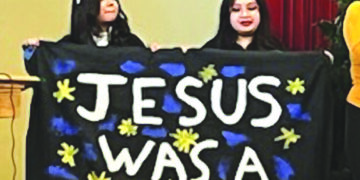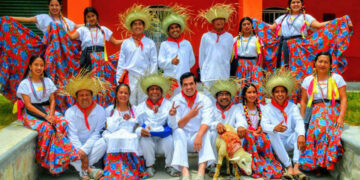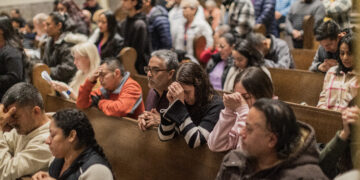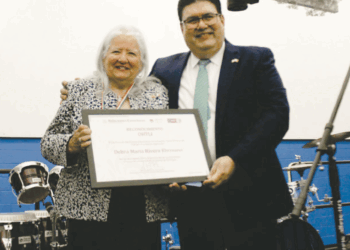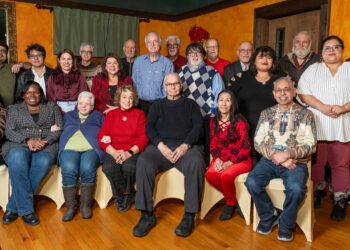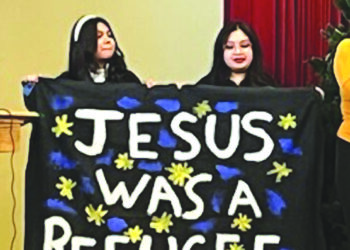Celebrated painter, cultural activist and gallerist Nora Chapa Mendoza has been named the 2024 Kresge Eminent Artist, considered metro Detroit’s most prestigious arts award.
“It’s an incredible thing to have happen in your life,’’ said Chapa Mendoza, 92. She is the 16th recipient since 2008 of the award recognizing a lifetime’s contribution to an artist’s chosen forms of expression and the cultural community of metro Detroit.

The honor includes an unrestricted prize of $100,000 (new this year – it previously had been $50,000) as well as production of a short film, a monograph, and other efforts to elevate the year’s artist by Kresge and Kresge Arts in Detroit, an office of the College for Creative Studies (CCS), which administers the effort.
“Her work conveys a rare combination of grace and perseverance in the face of the innumerable societal obstacles placed in the path of an artist with Chicano and Indigenous roots,’’ said Kresge President and CEO Rip Rapson. “She has inspired multiple generations with her full and powerful embrace of the overlapping causes of women, migrant workers and civil rights.”
The increase in the award size follows a decision by The Kresge Foundation to boost the region’s direct support to individual artists by upping both the per-award amount and the number of Kresge Artist Fellows, a companion program to the Kresge Eminent Artists. This summer, Kresge Arts in Detroit will announce 25 Kresge Artist Fellows who will each receive $40,000. Previously, The Kresge Foundation funded 20 fellows annually at $25,000 each.
“The larger number of larger awards expanded and deepened our decade-plus commitment to direct support to the working artists of greater Detroit,” said Rapson. “The increase in the Eminent Artist Award now follows suit to honor artists whose lifetime legacies contribute profoundly to today’s cultural vibrancy and whose impact will be felt for generations to come.”
“With deep ties to CCS and the Detroit community, Nora Chapa Mendoza is an inspiring example of an artist, educator and activist,” said College for Creative Studies President Donald L. Tuski. “Her dedication to addressing critical messages about civil rights and Chicano identity in her artwork communicates important historical and current issues. It is an honor to administer the Kresge Arts in Detroit program on behalf of The Kresge Foundation and to celebrate Nora Chapa Mendoza as the 2024 Kresge Eminent Artist.”
For Chapa Mendoza, this year’s Eminent Artist Award follows a banner 2023. Last fall, Detroit’s historic Scarab Club bestowed Chapa Mendoza with its highest honor, an invitation to “sign the beam.’’ The decades-old tradition has left a literal mark on the storied building’s ceiling and side beams with the handwritten signatures of 200-plus local and internationally renowned artists. Among the signatories are Diego Rivera, Isamu Noguchi, Norman Rockwell, Marcel Duchamp and previous Kresge Eminent Artists Charles McGee, Bill Rauhauser, Marie Woo and Shirley Woodson.
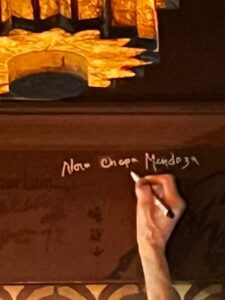
The signing was the culmination of Chapa Mendoza’s solo show at the Scarab Club, “Stages of a Life: A Retrospective.” The exhibition included assemblages, papier-mâché reliefs, and various mixed media works as well as paintings “as a captivating visual diary, offering profound insights into the rich tapestry of experiences that define her life,” as described by gallery director Dalia Reyes, who likened Chapa Mendoza to Frida Kahlo.
At the time, Chapa Mendoza viewed the honor as the zenith of a five-decade career that has taken the work of this largely self-taught artist “all over the world.”
“Putting my name up there, I mean, up there with Diego, that’s tops. It doesn’t get much better.”
Then just before Christmas, she got the call from Kresge Arts in Detroit.
“I thought it was a scam,” she said. “I still don’t believe it, that someone just called me up and offered me a chunk of money. It doesn’t really make sense, you know. I only do what I love. Every day I have to eat – I have to paint. Nothing special – just life.”
But Chapa Mendoza’s as an artist is, in fact, a wondrous tale.
Colors of Culture and Politics
The walls of her West Bloomfield Township home and the attached garage – converted to a studio years ago – are lined with tributes to her artistic and social impact.
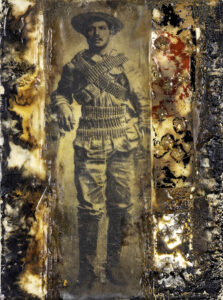
The framed award plaques, thank-you letters and official salutes from various social and government leaders reflect lifelong involvement in various causes including the fight for labor rights for migrant and farm workers, for women’s rights, and using art to expand awareness of Chicano history. She has also been recognized for uplifting her blended Native American ancestry and was named a Certified Elder of Kanto al Pueblo in Mesa, Arizona, in the 1980s.
She is especially proud of a signed letter from Cesar Chavez, the labor leader and civil rights activist who co-founded the National Farm Association, known today as the United Farm Workers union. In the late 1980s, Chapa Mendoza met Chavez at a conference. He learned she was an artist and later commissioned her to create a series of six paintings and a special collection of postcards to benefit the union’s efforts. The postcards and paintings were seen all over the world, she recalls. On her desk, she keeps a framed photo of the late Chavez as a reminder of his legacy and their work together.
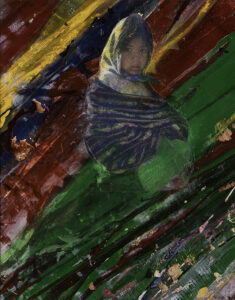
As a founding member of the Michigan Hispanic Cultural/Art Association and the former owner of her own gallery, Chapa Mendoza is beloved as a pioneering champion of Hispanic culture. Visual art, community observers say, just happens to be her means of expression.
In 1999, Gov. John Engler presented Chapa Mendoza with the Michigan Artist of the Year and Governor’s Award in recognition of long-standing cultural commitment to the state and, most notably, Southwest Detroit.
“In Southwest Detroit,’’ explains Osvaldo “Ozzie” Rivera, a well-known Detroit historian, musician and community activist, “there was a celebration when she signed the Scarab Club beam, a celebration across sectors, not just the artistic community. The business community showed up.’’
Rivera was a part of the five-member panel of metro Detroit artists and arts professionals, selected by Kresge Arts in Detroit to choose the 2024 Eminent Artist. Also on the panel was award-winning dancer and choreographer Gina Ellis.
“I just loved her work,’’ Ellis said, but added that “her continued involvement in the community is what stands out.’’
Other panelists were 2022 Kresge Eminent Artist Shirley Woodson, poet Dawn McDuffie and arts and culture producer Drake Phifer.
Chapa Mendoza’s unwavering commitment as an advocate for Chicano art and culture has also been recognized by the Smithsonian Institution. In 2018, a researcher for the Smithsonian’s Archives of American Art paid a visit to Chapa Mendoza with a request that she consider donating her paper, lectures, notes, sketches, exhibition catalogs and photographs as a way of documenting Detroit’s Hispanic arts and cultural contributions. Chapa Mendoza’s donation spans 1963 to 2013.
Rebirth in Detroit
Detroit is not the city where Nora Chapa Mendoza was born but it is the place where she came home to herself first as an artist and as an activist.
Chapa Mendoza’s city of birth is officially listed as Weslaco, Texas, in the heart of Rio Grande Valley. She entered the world there, just miles away from the Mexican border, on Jan. 20, 1932, as the youngest of Casimiro and Josefa Chapa’s three children.
Chapa Mendoza recalls her childhood as one of poverty and pain. Four days after Chapa Mendoza turned 4 years old, her mother died. Casimiro, a house painter, was suddenly a 25-year-old widower with three small children: Nora, the youngest; Jaime, the eldest; and middle-child Raquel. (Today, at 92, Chapa Mendoza is the sole survivor.)
“We lived in a one-room house,’’ she said. “There really wasn’t much opportunity.’’

Images of family members working the land in and around Weslaco — plucking citrus fruits and picking cotton, often beneath a white-hot sun — remain vivid. “I remember after my mother’s death, my aunt tied a potato sack to me, one in front and one on my back, and took me to pick cotton with her.’’
The aunt — who had eight children of her own — and Chapa Mendoza’s grandmother became the primary caregivers for young Nora and her siblings while their father, set out for Galveston, nearly 400 miles away, in search of more plentiful work.
The family’s struggles and agricultural lifestyle delayed Chapa Mendoza’s introduction to school until age 8, the year she began learning to speak English. Though she had to struggle to catch up academically, school opened a new world. It was where art first piqued her interest. She remembers being captivated by the vivid colors and images on Mexican calendars and in comic books.
Later, when she was about 14 and reunited with her father, that early spark began to catch fire. With her father’s encouragement, Chapa Mendoza picked up paint brushes. “Cans of paints and brushes were always around in the house. My father was the first person to encourage me, to teach me about colors.’’
Years later, in 1953, at age 21, she married, and followed her husband, Sam Mendoza, a doctor, to Detroit, where he’d been recruited for work. She brought her passion for painting with her – but only as a hobby.
The couple soon became parents to two children, daughter Laurie in 1956, and son Sam, three years later. In sync with the times, her husband, Chapa Mendoza says, insisted motherhood be her focus and priority. “He wanted me to paint,’’ she said, “but just in the basement. He didn’t want me exhibiting or anything because he wanted to be the person earning the money and supporting me,’’ Chapa Mendoza recalled. “I was supposed to be a good girl.’’
In 1973, Chapa Mendoza chose divorce. The choice changed everything. “It was a huge thing to do back then, a metamorphosis,’’ she said. “It felt like a rebirth. My whole life changed, and it hasn’t stopped.”
Chapa Mendoza studied art at the College for Creative Studies, then known as the Center for Creative Studies, and at Madonna University in Livonia. She also studied independently with well-known local artist mentors including painters Richard Kozlow and Ljubo Biro.
She became a founding member of Nuestras Artes de Michigan, a collective of Latin artists with chapters in Detroit, Pontiac and Ann Arbor. In 1981, she made a larger leap with the launch of Galeria Mendoza, in Detroit’s Harmonie Park district. The gallery was considered Detroit’s first solely Latin American showcase, with Chapa Mendoza’s paintings regularly paired with at least one new emerging Latin artist. Chapa Mendoza closed the gallery three years later to focus on her own painting.
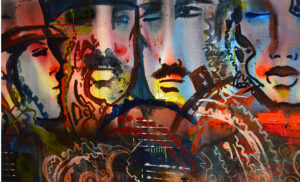
Chapa Mendoza’s trajectory has been wide-ranging, involving various mediums – oils, acrylics, canvas, boards, paper scraps, even a collection of discarded violins – partly because of her own fierce insistence that “beauty is in everything.’’
Initially, she sought to showcase this belief primarily through figurative paintings and drawings. Whatever she saw she worked to render with exactitude. “It’s like making a photograph, a way of seeing things.’’
Slowly, she turned her eye toward large oil-based landscapes. There, she discovered her most satisfying form, abstracts “with a little something hidden,’’ she said, referring to the playful way she likes to hide figurative images and forms with her landscapes.
Sometimes she chooses symbols of her Chicana heritage and Indigenous spirituality. She hides her fascination with horses in bold hues, too, along with a love of the female figure as an enduring study. “Abstract is more freeing. I don’t have to know, I just paint. The canvas and the colors, they take over. Whatever comes, comes.’’
Chapa Mendoza’s paintings and assemblages have been widely embraced by corporate and private collectors including Ford Motor Company, General Motors, Blue Cross/Blue Shield of Michigan, actor Edward James Olmos, Aretha Franklin, former Detroit Mayor Dennis Archer and former GM President Jack Smith. In 1998, Fidel Castro was presented with one of her paintings after two solo exhibitions in Cuba featured her paintings, which have also been exhibited as far away as Nicaragua, El Salvador and Egypt.
“I feel very honored by the life I’ve had,’’ she said. “I knew when I came to Detroit that it was special. I’m grateful to still do what I love every day and to represent my cultures. It’s a gift.’’
Chapa Mendoza joins a list of 15 previous Kresge Eminent Artist: visual artists Charles McGee, Ruth Adler Schnee, Marie Woo, Shirley Woodson and Olaymi Dabls; musicians Marcus Belgrave, Patricia Terry-Ross and Wendell Harrison; writers Bill Harris, Naomi Long Madgett, Gloria House and Melba Joyce Boyd; photographers Bill Rauhauser and Leni Sinclair; and composer-impresario David DiChiera.
This spring, Kresge Arts in Detroit will release a short film on Chapa Mendoza’s life and art produced by Desmond Love. The Kresge monograph will be released in the fall, available at no cost while supplies last and in perpetuity for download online.
Nora Chapa Mendoza Nombrada 2024 Kresge Eminent Artist
Honor considerado el premio artístico más prestigioso de Detroit
La célebre pintora, activista cultural y galerista, Nora Chapa Mendoza, ha sido nombrada Artista Eminente Kresge 2024, considerado el premio artístico más prestigioso del área metropolitana de Detroit.
“Es algo increíble que haya sucedido en tu vida”, comentó Chapa Mendoza, de 92 años. Ella es la decimosexta ganadora desde 2008 del premio que reconoce la contribución de toda una vida al arte y a la comunidad cultural del área metropolitana de Detroit.

Esta honra incluye un premio sin restricciones de 100.000 dólares (los premios anteriores eran de 50.000 dólares), así como la producción de un cortometraje, una monografía y otros esfuerzos para honrar al artista del año por parte de Kresge y Kresge Arts en Detroit, una oficina de la Facultad de Estudios Creativos (CCS), que administra el esfuerzo.
“Su trabajo transmite una rara combinación de gracia y perseverancia frente a los innumerables obstáculos sociales, colocados en el camino de un artista con raíces chicanas e indígenas”, mencionó el presidente y director ejecutivo de Kresge, Rip Rapson. “Ella ha inspirado a múltiples generaciones con su total y poderosa aceptación de las causas superpuestas de las mujeres, los trabajadores migrantes y los derechos civiles”.
El aumento en el premio, fue una decisión tomada por la Fundación Kresge para impulsar el apoyo directo de la región, a artistas individuales aumentando tanto el monto por premio como el número de Kresge Artist Fellows, un programa complementario de Kresge Eminent Artists. Este verano, Kresge Arts en Detroit anunciará 25 Kresge Artist Fellows, cada uno de los cuales recibirá 40.000 dólares. Anteriormente, la Fundación Kresge financiaba a 20 becarios anualmente con 25.000 dólares cada uno.
“El aumento en los premios, ha profundizado nuestro compromiso de más de una década de apoyo directo a los artistas que trabajan en el gran Detroit”, dijo Rapson. “El incremento en el Premio Eminent Artist, sigue el mismo camino para honrar a los artistas cuyo legado de toda la vida contribuye profundamente a la vitalidad cultural actual y cuyo impacto se sentirá en las generaciones venideras”.
“Con profundos vínculos con CCS y la comunidad de Detroit, Nora Chapa Mendoza es un ejemplo inspirador de artista, educadora y activista”, dijo el presidente de la Facultad de Estudios Creativos, Donald L. Tuski. “Su dedicación al abordar mensajes críticos sobre los derechos civiles y la identidad chicana en su obra de arte, comunica importantes temas históricos y actuales. Es un honor administrar el programa Kresge Arts en Detroit en nombre de la Fundación Kresge y celebrar a Nora Chapa Mendoza como una Artista Eminente de Kresge 2024”.
Para Chapa Mendoza, el Premio Premio Eminent Artist de este año es una continuación del año 2023, pues el otoño pasado, el histórico Scarab Club de Detroit otorgó a Chapa Mendoza su más alto honor, una invitación a “firmar la viga”. El techo y las vigas laterales del histórico edificio tiene las firmas de más de 200 artistas locales e internacionales de renombre. Entre los firmantes se encuentran Diego Rivera, Isamu Noguchi, Norman Rockwell, Marcel Duchamp y los anteriores Artistas Eminentes de Kresge, Charles McGee, Bill Rauhauser, Marie Woo y Shirley Woodson.

La firma fue la culminación de la exposición individual de Chapa Mendoza en el Scarab Club, “Stages of a Life: A Retrospective”. La exposición incluyó ensamblajes, relieves de papel maché y varias obras de técnica mixta, así como pinturas “como un diario visual cautivador, que ofrecía una visión profunda del rico tapiz de experiencias que definen su vida”, como lo describe la directora de la galería, Dalia Reyes, quien Comparó a Chapa Mendoza con Frida Kahlo.
En ese momento, Chapa Mendoza consideró el honor como el cenit de una carrera de cinco décadas que ha llevado el trabajo de esta artista en gran parte autodidacta “por todo el mundo”.
“Poner mi nombre ahí arriba, quiero decir, ahí arriba con Diego, eso es lo mejor. No hay nada mejor”.
Luego, justo antes de Navidad, recibió la llamada de Kresge Arts en Detroit.
“Pensé que era una estafa”, dijo. “Todavía no lo creo, que alguien me haya llamado y me haya ofrecido una buena cantidad de dinero. Realmente no tenía sentido, ¿sabes? Sólo hago lo que amo. Todos los días tengo que comer, tengo que pintar. Nada especial, sólo la vida”.
Pero la de Chapa Mendoza como artista es, de hecho, una historia maravillosa.
Colores de la cultura y la política
Las paredes de su casa en West Bloomfield Township y el garaje, convertido en estudio desde hace años, están revestidos de tributos a su impacto artístico y social.

Las placas de premios enmarcadas, cartas de agradecimiento y saludos oficiales de varios líderes sociales y gubernamentales reflejan la participación de toda su vida en diversas causas, incluida la lucha por los derechos laborales de los trabajadores migrantes y agrícolas, por los derechos de las mujeres y el uso del arte para ampliar la conciencia sobre la historia chicana. También ha sido reconocida por elevar su ascendencia nativa americana y fue nombrada Anciana legalizada de Kanto del Pueblo en Mesa, Arizona, en la década de 1980.
Está especialmente orgullosa de una carta firmada por César Chávez, líder sindical y activista de derechos civiles que cofundó la National Farm Associati, en adelante conocido, como el sindicato United Farm Workers. A finales de los años 1980, Chapa Mendoza conoció a Chávez en una conferencia. Se enteró de que ella era artista y luego le encargó que creara una serie de seis pinturas y una colección especial de postales en beneficio de los esfuerzos del sindicato. Las postales y los cuadros fueron vistos en todo el mundo, recuerda. En su escritorio, guarda una fotografía enmarcada del difunto Chávez como recordatorio de su legado y su trabajo juntos.

Como miembro fundador de la Asociación Cultural/Arte Hispana de Michigan y ex propietaria de su propia galería, Chapa Mendoza es adorada como una defensora pionera de la cultura hispana. El arte visual, dicen los observadores de la comunidad, resulta ser su medio de expresión.
En 1999, el gobernador John Engler le otorgó a Chapa Mendoza el premio al Artista del Año de Michigan y el Premio del Gobernador en reconocimiento al compromiso cultural de larga trayectoria con el estado y, más notablemente, con el suroeste de Detroit.
“En el suroeste de Detroit”, explica Osvaldo “Ozzie” Rivera, un conocido historiador, músico y activista comunitario de Detroit, “hubo una celebración cuando ella firmó la viga del Scarab Club, una celebración que abarcó a todos los sectores, no solo a la comunidad artística. La comunidad empresarial apareció”.
Rivera formó parte del panel de cinco miembros de artistas y profesionales del arte del área metropolitana de Detroit, seleccionados por Kresge Arts para elegir al Artista Eminente del 2024. También en el panel estuvo la galardonada bailarina y coreógrafa Gina Ellis.
“Me encantó su trabajo”, dijo Ellis, pero añadió que “lo que se destaca es su continua participación en la comunidad”.
Otros panelistas fueron la Artista Eminente del 2022, Shirley Woodson, la poeta Dawn McDuffie y el productor de arte y cultura Drake Phifer.
El compromiso inquebrantable de Chapa Mendoza como defensora del arte y la cultura chicanos también ha sido reconocido por la Institución Smithsonian. En 2018, un investigador de los Archivos de Arte Americano del Smithsonian visitó a Chapa Mendoza y le pidió que considerara donar sus artículos, conferencias, notas, bocetos, catálogos de exposiciones y fotografías como una forma de documentar las artes y las contribuciones culturales hispanas de Detroit. La donación de Chapa Mendoza abarca desde 1963 hasta 2013.
El Renacimiento en Detroit
Detroit no es la ciudad donde nació Nora Chapa Mendoza, pero es el lugar donde volvió a sentirse como artista y activista.
La ciudad natal de Chapa Mendoza figura oficialmente como Weslaco, Texas, en el corazón del Valle del Río Grande. Allí llego al mundo, a pocos kilómetros de la frontera con México, el 20 de enero de 1932, como la menor de tres hijos de Casimiro y Josefa Chapa.
Chapa Mendoza recuerda su infancia como una infancia de pobreza y dolor. Cuatro días después de que Chapa Mendoza cumpliera 4 años, murió su madre. Casimiro, pintor de casas, se convirtió de pronto en un viudo de 25 años y con tres hijos pequeños: Nora, la menor; Jaime, el mayor; y Raquel, la hija del medio. (Hoy, a los 92 años, Chapa Mendoza es la única sobreviviente).
“Vivíamos en una casa de una sola habitación”, dijo. “Realmente no había muchas oportunidades”.

Las imágenes de miembros de la familia trabajando la tierra en Weslaco y sus alrededores, recogiendo cítricos y algodón, a menudo bajo un sol candente, siguen siendo vívidas. “Recuerdo que después de la muerte de mi madre, mi tía me ató un saco adelante y otro atrás, y me llevó a recoger algodón con ella”.
La tía, que tenía ocho hijos, y la abuela de Chapa Mendoza se convirtieron en las principales cuidadoras de la joven Nora y sus hermanos, mientras que su padre partió hacia Galveston, a casi 400 millas de distancia, en busca de un mejor trabajo.
Las luchas de la familia y el estilo de vida agrícola retrasaron la introducción de Chapa Mendoza a la escuela hasta los 8 años, año en que comenzó a aprender a hablar inglés. Aunque tuvo que luchar para ponerse al día académicamente, la escuela le abrió un mundo nuevo. Fue allí donde el arte despertó por primera vez su interés. Recuerda haber quedado cautivada por los colores vivos y las imágenes de los calendarios mexicanos y de las historietas.
Más tarde, cuando tenía unos 14 años y se reunió con su padre, esa chispa inicial comenzó a prender fuego. Con el apoyo de su padre, Chapa Mendoza tomó pinceles. “Siempre había botes de pintura y pinceles en la casa. Mi padre fue la primera persona que me animó y me enseñó sobre los colores”.
Años más tarde, en 1953, a los 21 años, se casó y siguió a su esposo, el médico Sam Mendoza, a Detroit, donde lo habían contratado para trabajar, trajo consigo su pasión por la pintura, pero sólo como pasatiempo.
Pronto se convirtieron en padres de dos hijos, su hija Laurie nació en 1956 y su hijo Sam, tres años después. En concordancia con esa época, su esposo, insistió que la maternidad fuera su enfoque y prioridad. “Él quería que pintara”, dijo, “pero sólo en el sótano. No quería que yo expusiera, ni nada porque quería ser la persona que ganara el dinero y me apoyara”, recordó Chapa Mendoza. “Se suponía que yo era una buena chica”.
En 1973, Chapa Mendoza optó por el divorcio. La decisión lo cambió todo. “Fue algo enorme en ese entonces, una metamorfosis”, dijo. “Eso se sintió como un renacimiento. Toda mi vida cambió y no se ha detenido”.
Chapa Mendoza estudió arte en la Facultad de Estudios Creativos (conocida entonces como Centro de Estudios Creativos), y en la Universidad Madonna de Livonia. También estudió de forma independiente con reconocidos mentores de artistas locales, incluidos los pintores Richard Kozlow y Ljubo Biro.
Se convirtió en miembro fundador de Nuestras Artes de Michigan, un colectivo de artistas latinos de Detroit, Pontiac y Ann Arbor. En 1981, dio un salto mayor con el lanzamiento de la Galería Mendoza, en el distrito Harmonie Park de Detroit. La galería fue considerada la primera muestra exclusivamente latinoamericana de Detroit, y las pinturas de Chapa Mendoza se combinan regularmente con al menos un nuevo artista latino emergente. Chapa Mendoza cerró la galería tres años después para centrarse en su propia pintura.

La trayectoria de Chapa Mendoza ha sido amplia e involucró varios medios (óleos, acrílicos, lienzos, tablas, papel scraps e incluso una colección de violines desechados) en parte debido a su feroz insistencia en que “la belleza está en todo”.
Inicialmente, buscó mostrar esta creencia principalmente a través de pinturas y dibujos figurativos. Todo lo que vio, trabajó para representarlo con exactitud. “Es como hacer una fotografía, una forma de ver las cosas”.
Lentamente, volvió su mirada hacia grandes paisajes en óleo. Allí descubrió su forma más satisfactoria, el abstracto “con algo escondido”, dijo, refiriéndose a la forma lúdica en la que le gusta ocultar imágenes y formas figurativas con sus paisajes.
A veces elige símbolos de su herencia chicana y espiritualidad indígena. También oculta su fascinación por los caballos en tonos atrevidos, junto con su amor por la figura femenina como estudio duradero. “Lo abstracto es más liberador. No tengo por qué saberlo, solo pinto. El lienzo y los colores se hacen cargo. Lo que venga, llega”.
Las pinturas y ensamblajes de Chapa Mendoza han sido ampliamente acogidos por coleccionistas corporativos y privados, incluidos Ford Motor Company, General Motors, Blue Cross/Blue Shield of Michigan, el actor Edward James Olmos, Aretha Franklin, el ex alcalde de Detroit Dennis Archer y el ex presidente de GM Jack Smith. En 1998, Fidel Castro recibió una de sus pinturas después de dos exposiciones individuales en Cuba que incluyeron sus pinturas, que también se han exhibido en lugares como Nicaragua, El Salvador y Egipto.
“Me siento muy honrada por la vida que he tenido”, dijo. “Cuando llegué a Detroit, supe que era especial. Estoy agradecida de seguir haciendo lo que amo todos los días y representar mis culturas. Es un regalo.”
Chapa Mendoza se une a la lista de 15 artistas eminentes de Kresge: los artistas visuales Charles McGee, Ruth Adler Schnee, Marie Woo, Shirley Woodson y Olaymi Dabls; los músicos Marcus Belgrave, Patricia Terry-Ross y Wendell Harrison; los escritores Bill Harris, Naomi Long Madgett, Gloria House y Melba Joyce Boyd; los fotógrafos Bill Rauhauser y Leni Sinclair; y el compositor y empresario David DiChiera.
Esta primavera, Kresge Arts en Detroit estrenará un cortometraje sobre la vida y el arte de Chapa Mendoza producido por Desmond Love. La monografía de Kresge se lanzará en el otoño, estará disponible sin costo hasta agotar existencias y a perpetuidad para descargar en línea.
Traducción por Carmen Elena Luna



